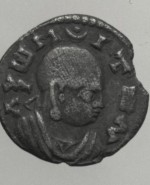Aksumite Coins Photo credit: Walters Art Museum
Location: Walters Art Museum 600 N Charles St, Baltimore, MD 21201
The Aksumite kingdom was located in what is now northern Ethiopia and Eritrea and lasted almost a thousand years, from the 1st to 8th century C.E. The kingdom began to issue coins about AD 270. Aksumite coins were one of major global currencies of the ancient world.
“Silver and bronze coins were issued for local, everyday use, and generally followed the design of Roman coins with a bust portrait of the ruler in profile on one side. Aksumite coins were the first in the ancient world to carry the cross as a symbol of the ruler’s devotion to the Christian religion.” Walters ArtMuseum
A clearer image of the Christian cross can be seen below on the coin of the Aksumite King Joel, 6th century C.E. Askumite coins were struck in gold, copper and silver. Gold coins were generally inscribed in Greek and intended for international exchange. Silver and copper coins were inscribed in Ge’ez (Aksumite script) and used locally. Khan Academy

Coin of King Joel, 6th century C.E., Aksum, Photo credit: British Museum
Resources:
“Askumite Coins. Khan Academy. https://www.khanacademy.org (last visited June 2, 2019).
The British Museum, “Aksumite Coins,” in Smarthistory, September 23, 2016, accessed September 6, 2020, https://smarthistory.org/aksumite-coins/.
“The wealth of Africa: the kingdom of Askum.” British Museum. www.britishmuseum.org (last visited June 2, 2019).

